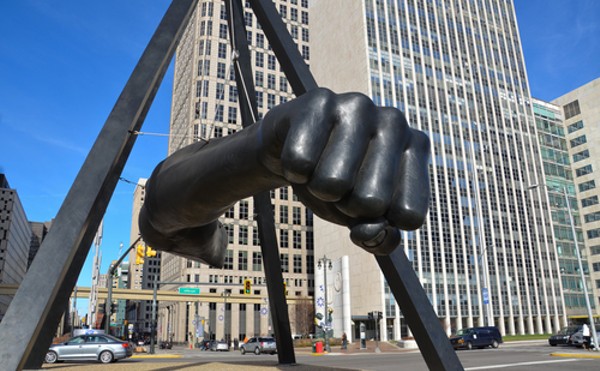There were signs. People were watching. Still, it burned.
The First Unitarian Church — red sandstone, points, and arches — stood at the corner of Woodward and Edmund. At its first service in November 1890, the new church was presented to Thomas Palmer, the Unitarian namesake of Palmer Park. He accepted it with words that would echo nearly 125 years later, under much changed circumstances:
... I accept this structure in the name of the people — in the name of the people who shall come here to worship — in the name of the good, who will come here and receive stimulation to further endeavor — in the name of the bad, who will come here and be led to see the error of their ways — in the name of the young, who will here see examples, which shall stimulate them to greater good — in the name of the sinful and erring, who will here find an atmosphere and teachings which will induce them to live different lives.
Unitarians gathered here to sing and pray, to inspire one another into believing in the best of their community. In 1936, when Woodward was widened, the church rebuilt farther back, excising its porch and shortening the turret. Stunning stained glass — the "Helping Angel" panels — were given to the Detroit Institute of Arts, where you can see them today.
During reconstruction, the congregation nested at the Universalist Church on Cass Avenue, and liked it so well, they merged. The First Unitarian Church was sold in 1937. Then, it was sold again. In latter years, the church became a sanctuary of a different sort: homeless taking shelter. With a high-traffic location and historic protection, the church, though vacant, was not abandoned.
It wasn't enough.
One year ago, Preservation Detroit heard from a Brush Park resident who spied work crews at the church. According to Amy Elliott Bragg, president of the board, workers said they were prepping for demolition. The preservationists asked the city's Historic District Commission for details. No demolition permits had been submitted or approved, but not long after, the owner asked HDC about a tear-down.
According to Bragg, the owner was told that "it was extremely unlikely that the HDC would approve a petition to demo the building, and that after a while, the owner stopped asking about it." The city's Building, Safety Engineering, and Environmental Department was given a heads-up, and joined neighbors in keeping an eye on the church.
Around the same time, Amy Haimerl was looking for salvaged materials for the east side home she and her husband are restoring. As she described it in a blog post, they toured First Unitarian. "We were told the owner had secured demolition permits and the church was scheduled to come down in the coming weeks," she wrote. "We were meeting an architectural salvage man who had the contract to remove anything worthwhile before the wrecking ball came down. He had the keys."
Haimerl bought the church's salvageable doors, wainscoting, and the gallery railing. "We felt good that a once-beautiful place would be upcycled to the future," she wrote.
A week later, Haimerl's contractors and salvage agent returned. The agent warned those who lived inside to leave because, he said, the building was coming down within days. "It seemed odd that there wouldn't have been an official posting or notification before demolition, but I didn't give it much more thought," Haimerl wrote.
The church didn't come down after all. Haimerl guessed that it was delayed by the polar vortex.
Then, on a bright morning in May of this year, the church burned. Flames spread uncommonly fast. First Unitarian was gutted.
Arson investigators arrived. So did cleanup crews: with startling speed, large-scale machinery demolished what remained after the fire, not only eliminating what could still be preserved, but also erasing possible evidence of wrongdoing. Or, in fairness, evidence that the church burned because of a stray cigarette, a mis-fallen ember.
Who owned the church? According to MLive's review, it's Salim Kemenko of Waterford, and while taxes were $0 in 2011, they jumped to $133,120 in recent years. The church stands one block north of where the Midtown development around the new Red Wings hockey arena will be built, making the land underneath the church increasingly valuable. Motor City Muckracker pointed out that Kemenko, who owns numerous Detroit properties, isn't a stranger to fire or negligence: His Waterford home burned in 2008. He left the charred remains sitting for a year because, he said, of an insurance dispute.
Preservation Detroit considers the First Unitarian fire "extremely suspicious."
"Even if the owner was not directly responsible for the arson, the building had clearly been significantly neglected, open to the elements and to trespass, and vulnerable to damage exactly like the arson that ultimately destroyed it," Bragg says.
Haimerl was horrified by the fire and how her effort at good-faith salvage made her feel like a scrapper. She tells us she's glad that pieces of the church, a "that tiny bit of Detroit history," did not burn; they live on in the home she is building.
A week after the fire, among the brick and stone, gatherers returned to First Unitarian for a memorial service, clutching candles and singing a hymn. Horns played a requiem of sorts. With Bragg reviving it, Palmer's dedication rang clear at both the church's first and final services:
... Where are those faces which I used to see in this congregation? They have disappeared from our sight. Yet they come to me today and seem to rejoice with us in our fortune. In the name of them who have gone from us and those who shall come in the future, I accept this building as a place where souls may be uplifted from evil ways and habits and led to a perfect rest.
The city sued Kemenko over the cleanup. Large piles of debris were left behind, creating a danger and an eyesore. But arson investigators have yielded no results to date. "We're working on it," is the going phrase.
Actions that prevent negligence and fire from recurring, such as code enforcement, are under-resourced. The Historic District Commission has an impossibly tiny staff. In a city with a thousand priorities, this one hasn't risen to the top.
"Then again," says Bragg, "I'm also not sure that any major city has fully figured out how to deal, mitigate, investigate, and prosecute arson."
We are left with only the accountability that comes from remembering.
Let it be a stimulation to higher endeavor wherein we shall come to divulge the mysteries of God's ways and the mysteries of man.





